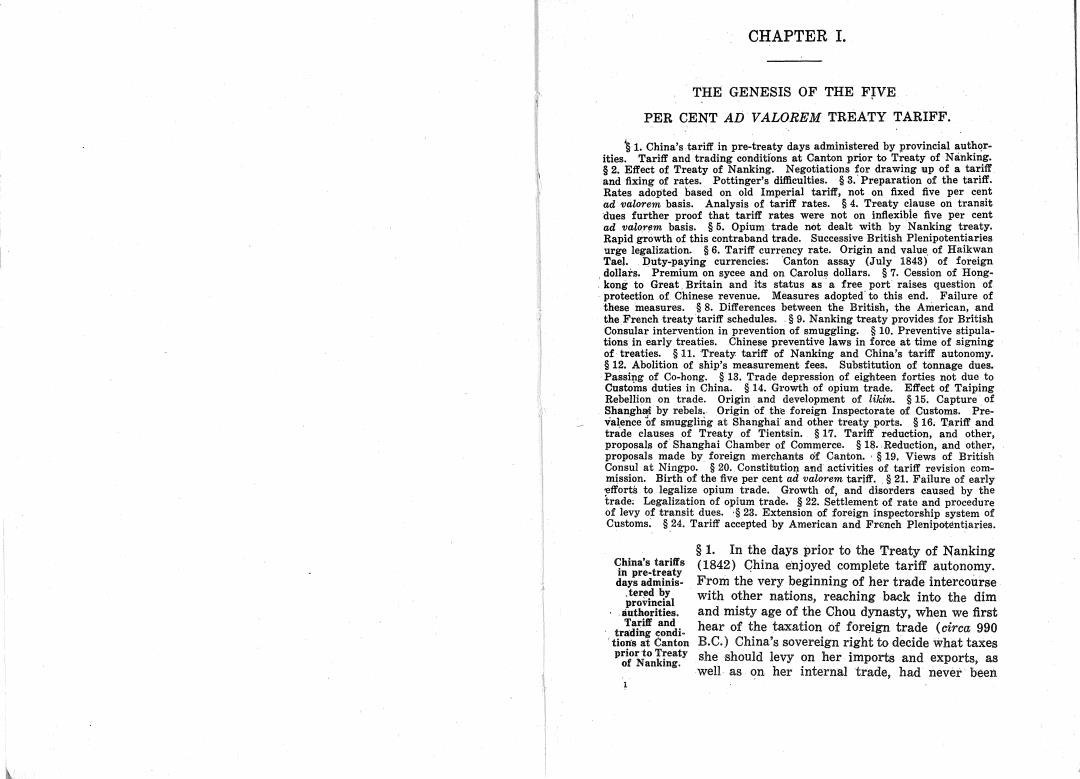正在加载图片...

CHAPTER I. THE GENESIS OF THE FIVE PER CENT AD VALOREM TREATY TARIFF. $1.China's tariff in pre-treaty days administered by provincial author- ities.Tariff and trading conditions at Canton prior to Treaty of Nanking. $2.Effect of Treaty of Nanking.Negotiations for drawing up of a tariff and fixing of rates. Pottinger's difficulties.$3.Preparation of the tariff. Rates adopted based on old Imperial tariff,not on fixed five per cent ad valorem basis.Analysis of tariff rates.$4.Treaty clause on transit dues further proof that tariff rates were not on inflexible five per cent ad valorem basis.$5.Opium trade not dealt with by Nanking treaty. Rapid growth of this contraband trade.Successive British Plenipotentiaries urge legalization.$6.Tariff currency rate.Origin and value of Haikwan Tael.Duty-paying currencies:Canton assay (July 1848)of foreign dollars. Premium on sycee and on Carolus dollars.7.Cession of Hong- kong to Great Britain and its status as a free port raises question of protection of Chinese revenue. Measures adopted to this end. Failure of these measures.$8.Differences between the British,the American,and the French treaty tariff schedules.$9.Nanking treaty provides for British Consular intervention in prevention of smuggling.10.Preventive stipula- tions in early treaties.Chinese preventive laws in force at time of signing of treaties. $11.Treaty tariff of Nanking and China's tariff autonomy. $12.Abolition of ship's measurement fees. Substitution of tonnage dues. Passing of Co-hong.13.Trade depression of eighteen forties not due to Customs duties in China. $14.Growth of opium trade. Effect of Taiping Rebellion on trade.Origin and development of likin. $15.Capture of Shanghat by rebels.Origin of the foreign Inspectorate of Customs. Pre- valence of smuggling at Shanghai and other treaty ports.16.Tarifl and trade clauses of Treaty of Tientsin.17.Tariff reduction,and other, proposals of Shanghai Chamber of Commerce.$18.Reduction,and other, proposals made by foreign merchants of Canton.$19.Views of British Consul at Ningpo. $20.Constitution and activities of tariff revision com- mission.Birth of the five per cent ad valorem tariff.$21.Failure of early efforts to legalize opium trade.Growth of,and disorders caused by the trade:Legalization of opium trade.$22.Settlement of rate and procedure of levy of transit dues.$28.Extension of foreign inspectorship system of Customs.24.Tariff accepted by American and French Plenipotentiaries $1.In the days prior to the Treaty of Nanking China's tariffs in pre-treaty (1842)China enjoyed complete tariff autonomy. days adminis. From the very beginning of her trade intercourse .tered by provincial with other nations,reaching back into the dim authorities and misty age of the Chou dynasty,when we first Tariff and trading condi- hear of the taxation of foreign trade (circa 990 tions at Canton B.C.)China's sovereign right to decide what taxes prior to Treaty of Nanking. she should levy on her imports and exports,as well as on her internal trade,had never beenCHAPTER I. THE GENESIS OF THE F~VE PER CENT AD VALOREM TREATY TARIFF. ~ 1. China's tariff in pre-treaty days administered by provincial authqrities. Tariff and trading conditfons at Canton prior to Treaty of Nanking. § 2. Effect of Treaty of NankIng. Negotiations for drawing up of a tariff and fixing of rates. Pottinger's difficulties. § 3.' Preparation of the tariff. Rates adopted based on old Imperial tariff, not on fixed five per cent ad valorem basis. Analysis of tariff rates. § 4. Treaty clause on. transit dues further proof that tariff rates were not on inflexibie five per cent ad valor~m basis. § 5. Opium trade oot dealt with by Nanking treaty. Rapid growth of this contraband trade. Successive British Plenipotentiaries urge legalization. § 6. Tariff currency rate. Origin and value. of Haikwan Tael. Duty-paying currencies: 'Canton assay (July 1843) of foreign dollars. Premium on sycee and on Carolus dollars. § 7. Cession of Hong- . kong to Great. Britain and its status as' a free port raises question of protection of Chinese revenue. Measures adopted'to this end. Failure of these measures. § 8. Differences between the British, the American, and the French treatytariff schedules .. § 9. Nanking treaty provides for British Consular intervention in prevention of smuggling. § 10. Preventive stipulations in early treaties. Chinese preventive laws in force at time of signing of treaties. § 11. Treaty tariff of Nanking and China's tariff autonomy. § 12. Abolition of ship's measurement fees. Substitution of tonnage dues. Passing of Co-hong. § 13. Trade depression of eighteen forties not due to Customs duties in China. § 14. Growth of opium trade. Effect of Taiping Rebellion on trade. Origin and development of likin. § 15. Capture. of Shanghai by rebels. Origin of the foreign Inspectorate of Customs. Preval,ence 'Of smuggling at Shanghai and other treaty ports. § 16. Tariff and trade c1ausesof Treaty of Tientsin. § 17. Tariff reduction, and other, proposals of Shanghai Chamber of Commerce. § 18. Reduction, and other, proposals made by foreign merchants <if Canton. ' § 19. Views of British Consul at Ningpo. § 20 .. Constitution and activities of tariff revision commission. Birth of the five per cent ad valorem tariff .. § 21. Failure of early ;efforts to . legalize opium trade. Growth of, and disorders caused by the trade; Legalization of opium trade. § 22. Settlement of rate and procedure of levy of transit dues. ,§ 23. Extension of foreign inspectorship system of Customs. § ,24. Tariff accepted by American and French Plenipotentiaries. China's tariffs in pre-treaty days adminis- .tered by provincial , . authorities. Tariff and , trading conditions at Canton prior to Treaty of Nanking. § 1. In the days prior to the Treaty of Nanking (1842) Ghina enjoyed complete tariff autonomy. From the very beginning of her trade intercourse with other nations, reaching back into the dim and misty age of the Chou dynasty, when we first hear of the taxation of foreign trade (circa 990 B.C.) China's sovereign right to decide what taxes she should levy on her imports and exports, as well as on her internal trade, had never been